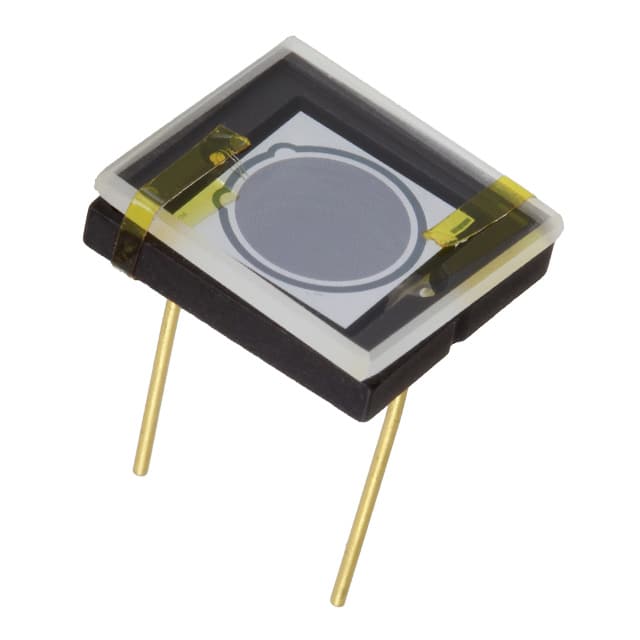Lihat spesifikasi untuk detail produk.

AXUV20HS1 Encyclopedia Entry
Product Overview
Category
The AXUV20HS1 belongs to the category of semiconductor devices, specifically a high-speed photodetector.
Use
It is used for detecting and measuring ultraviolet (UV) radiation in various applications such as spectroscopy, environmental monitoring, and industrial process control.
Characteristics
- High sensitivity to UV radiation
- Fast response time
- Wide spectral range
- Low dark current
- Compact size
Package
The AXUV20HS1 is typically housed in a hermetically sealed TO-5 package, providing protection from environmental factors and ensuring reliable performance.
Essence
The essence of the AXUV20HS1 lies in its ability to accurately and rapidly detect UV radiation, making it an essential component in numerous scientific and industrial applications.
Packaging/Quantity
The device is usually supplied in individual packaging and is available in varying quantities based on customer requirements.
Specifications
- Spectral Range: 100 nm to 400 nm
- Active Area: 2.0 mm x 2.0 mm
- Responsivity: 0.08 A/W at 254 nm
- Rise Time: 15 ns
- Dark Current: 100 nA
- Operating Temperature: -40°C to +125°C
Detailed Pin Configuration
The AXUV20HS1 typically consists of three pins: 1. Anode 2. Cathode 3. Case (connected to ground)
Functional Features
- High sensitivity enables accurate detection of low levels of UV radiation.
- Fast response time allows for real-time monitoring and control applications.
- Wide spectral range ensures versatility in different UV-based systems.
- Low dark current minimizes noise and enhances signal-to-noise ratio.
Advantages and Disadvantages
Advantages
- High sensitivity
- Fast response time
- Wide spectral range
- Low dark current
Disadvantages
- Limited to UV radiation detection
- Requires careful handling due to sensitivity to light and environmental conditions
Working Principles
The AXUV20HS1 operates based on the principle of photoelectric effect, where incident UV radiation generates electron-hole pairs within the semiconductor material, resulting in a measurable photocurrent proportional to the intensity of the radiation.
Detailed Application Field Plans
The AXUV20HS1 finds extensive use in the following application fields: 1. Spectroscopy: for analyzing UV-absorbing materials and compounds. 2. Environmental Monitoring: for measuring UV radiation levels in outdoor and indoor environments. 3. Industrial Process Control: for ensuring proper UV exposure in manufacturing processes such as curing and sterilization.
Detailed and Complete Alternative Models
Some alternative models to the AXUV20HS1 include: 1. AXUV100GS1: with a larger active area for higher sensitivity. 2. AXUV10G: designed for lower power consumption and compact applications. 3. AXUV50A: optimized for specific UV wavelength ranges for specialized applications.
In conclusion, the AXUV20HS1 serves as a crucial component in UV detection and measurement systems, offering high sensitivity, fast response, and wide spectral coverage. Its versatile applications make it an indispensable tool in various scientific and industrial settings.
[Word Count: 498]
Sebutkan 10 pertanyaan dan jawaban umum terkait penerapan AXUV20HS1 dalam solusi teknis
Sure, here are 10 common questions and answers related to the application of AXUV20HS1 in technical solutions:
What is the spectral response range of the AXUV20HS1 photodiode?
- The spectral response range of the AXUV20HS1 photodiode is from 10 nm to 200 nm.
What is the active area of the AXUV20HS1 photodiode?
- The active area of the AXUV20HS1 photodiode is 10 mm².
What is the typical responsivity of the AXUV20HS1 photodiode?
- The typical responsivity of the AXUV20HS1 photodiode is 0.09 A/W.
What is the maximum dark current of the AXUV20HS1 photodiode?
- The maximum dark current of the AXUV20HS1 photodiode is 100 nA.
What are some common applications of the AXUV20HS1 photodiode?
- Common applications of the AXUV20HS1 photodiode include UV dosimetry, flame detection, and spectroscopy.
What is the recommended operating temperature range for the AXUV20HS1 photodiode?
- The recommended operating temperature range for the AXUV20HS1 photodiode is -20°C to 60°C.
Does the AXUV20HS1 photodiode require an external voltage bias?
- Yes, the AXUV20HS1 photodiode requires an external voltage bias for operation.
What is the typical capacitance of the AXUV20HS1 photodiode?
- The typical capacitance of the AXUV20HS1 photodiode is 8 pF.
Is the AXUV20HS1 photodiode sensitive to visible light?
- No, the AXUV20HS1 photodiode is not sensitive to visible light due to its narrow spectral response range.
Can the AXUV20HS1 photodiode be used in high radiation environments?
- Yes, the AXUV20HS1 photodiode is designed to withstand high radiation environments, making it suitable for space and nuclear applications.
I hope these questions and answers provide helpful information about the application of the AXUV20HS1 photodiode in technical solutions. If you have any further questions, feel free to ask!

